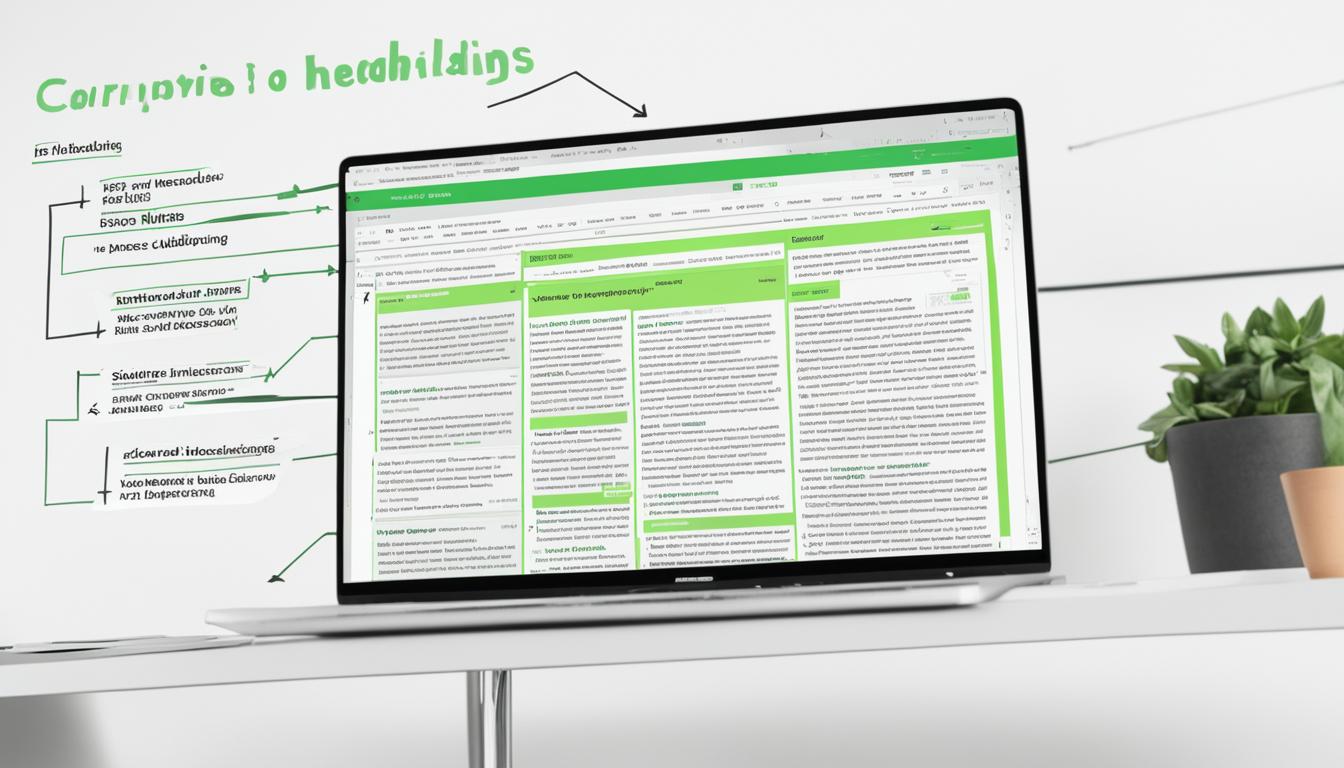I have found that incorporating visual elements into SEO writing can significantly enhance the impact and effectiveness of the content. Visuals not only make the content more engaging and memorable but also play a crucial role in optimizing the overall search engine optimization (SEO) strategy. In today’s digital landscape, where attention spans are shorter and competition is fierce, visual content has become a powerful tool for attracting and retaining website visitors, as well as improving search rankings.
By optimizing images and using SEO-friendly visuals, companies can increase user engagement, improve time-on-page statistics, and reduce bounce rates. Visuals come in many forms, such as images, infographics, videos, and other visual elements, each serving a specific purpose. Incorporating these visuals strategically and optimizing them for SEO can have a profound impact on the visibility and effectiveness of the content.
Key Takeaways:
- Incorporating visual elements in SEO writing can enhance the impact and effectiveness of the content.
- Visuals attract and retain website visitors, improving user engagement and reducing bounce rates.
- Optimizing images and using SEO-friendly visuals can boost search rankings and organic traffic.
- Various forms of visuals, such as infographics and videos, can be strategically incorporated to improve content engagement.
- Optimizing visuals for SEO, including alt text and metadata, is essential for better search visibility.
When it comes to SEO, incorporating visual content can have a significant impact on website performance. Visuals not only add value to web pages but also play a crucial role in enhancing search engine optimization (SEO). As a writer, optimizing SEO with visuals is essential to attract and engage the target audience. Let’s explore the importance of visuals in SEO and how they can enhance your content strategy.
The Value of Visual Content
Visual content is highly effective in keeping visitors on a website and reducing bounce rates. By including relevant and engaging visuals, you can guide readers through the content, making it easier to consume and understand. Not only do visuals capture attention, but they also evoke emotions and create a more memorable experience. With Google’s machine learning algorithms developing the ability to read visuals, it has become increasingly important to ensure that images are relevant, well-formatted, and optimized for readability.
Optimizing SEO with Visuals
Visuals play a critical role in SEO because they contribute to various factors that determine a website’s ranking. To optimize SEO with visuals, consider the following:
- Choosing high-quality visuals that align with your content and target audience.
- Including descriptive and keyword-rich alt text for images to improve their discoverability.
- Compressing images to optimize website loading speed.
- Incorporating videos to enhance engagement and increase time spent on the page.
- Using infographics to present complex information in a visually appealing and easily digestible format.
“Visual content not only attracts and captivates viewers but also contributes to better SEO performance.”
– Jane Smith, SEO Specialist at XYZ Agency
By implementing these strategies, you can effectively enhance your SEO efforts and maximize the impact of visual content in your writing.
The Importance of Visuals in Content Writing

Visuals play a crucial role in content writing, enhancing readability, comprehension, and user engagement. Incorporating visual elements into your SEO strategy can optimize search engine visibility and improve the impact of your message. This section explores the importance of visuals in content writing and how they contribute to effective SEO.
Visuals have the power to create emotional connections with the audience. They capture attention and maintain it throughout the content, ensuring that readers stay engaged. Breaking up long blocks of text with visually appealing elements such as images, infographics, or videos provides a welcome respite for the eyes and helps prevent information overload.
Visuals add a personal touch to your content, allowing you to connect with readers on a deeper level. Whether it’s through relatable images, captivating infographics, or compelling videos, visuals have the ability to evoke feelings and evoke a sense of connection.
Visual storytelling is a powerful tool in SEO writing. By incorporating visuals that tell a story, you can effectively communicate complex ideas and concepts in a succinct and memorable manner. Storytelling through visuals engages readers, making the content more relatable and compelling.
Visuals in content writing improve readability and comprehension, create emotional connections, capture attention, and enhance user engagement. Incorporating visual storytelling techniques can elevate your SEO strategy and help you stand out in the crowded online landscape.
Types of Visuals for Content Writing

When it comes to content writing, incorporating visual elements can greatly enhance the effectiveness of your SEO strategy. Visual content in SEO not only captures attention but also improves engagement and helps convey information more effectively. There are several types of visuals that you can utilize to enhance your content:
1. Images
Images are one of the most commonly used visual elements in content writing. They can serve various purposes such as illustrating key points, creating visual interest, or simply enhancing the overall aesthetic appeal of your content. When using images in your SEO writing, it’s important to choose high-quality images that are relevant to your topic and optimize them for web use.
2. Infographics
Infographics are a powerful way to visually represent complex information or data. They allow you to present information in a visually appealing and easy-to-understand format. Infographics can be used to illustrate statistics, explain concepts, or provide step-by-step instructions. When incorporating infographics into your content, make sure to optimize them for SEO by including relevant keywords in the title, alt text, and description.
3. Charts/Graphs
Charts and graphs are effective visual aids for presenting data and statistical information. They help simplify complex data and make it easier to understand. By incorporating charts or graphs into your content, you can provide your readers with a visual representation of the information, making it more accessible and engaging.
4. Videos
Videos are highly engaging and can captivate your audience’s attention. Incorporating videos in your SEO writing can help you deliver your message in a more dynamic and interactive way. You can create tutorial videos, product reviews, or even video interviews to provide valuable information to your audience. Remember to optimize your videos for SEO by adding relevant keywords to the title, description, and tags.
By incorporating these visual elements strategically into your content, you can enhance the overall user experience, improve engagement, and ultimately boost your SEO efforts.
| Visuals | Purpose |
|---|---|
| Images | Illustrate key points and enhance visual appeal |
| Infographics | Present complex information in a visually appealing format |
| Charts/Graphs | Simplify and visualize data or statistical information |
| Videos | Create dynamic and interactive content |
Strategies for Using Visuals in Content Writing

When it comes to incorporating visuals into your content writing, there are several key strategies to keep in mind. By implementing these strategies, you can optimize visual content for better SEO and enhance its overall impact. Here are some effective strategies to consider:
- Align visuals with content goals: Before selecting any visuals, ensure they align with your content goals and overall message. This will help maintain consistency and relevance throughout your content.
- Use relevant and high-quality visuals: Select visuals that are directly related to the topic at hand and of high quality. Avoid using generic or irrelevant visuals as they can detract from the overall user experience.
- Optimize visuals for web use: Ensure that your visuals are optimized for web use to improve page load times and user experience. Compress images when necessary and consider using responsive design techniques to ensure visuals are displayed properly across different devices.
- Incorporate visuals strategically: Place visuals strategically within your content to enhance readability and engagement. For example, you can use visuals to break up long blocks of text, illustrate key points, or provide examples.
- Provide context and captions: When using visuals, provide context and captions to help readers understand the purpose and significance of the visuals. This will enhance the overall user experience and improve engagement.
- Test different visual formats: Experiment with different visual formats to see what resonates best with your audience. This can include images, infographics, charts/graphs, or even videos. Analyze the performance of each format and adjust your strategies accordingly.
- Optimize visuals for SEO: In addition to optimizing your written content, don’t forget to optimize your visuals for SEO as well. Use descriptive filenames, include relevant alt text, and consider adding captions or annotations to your visuals.
- Leverage social media platforms: Take advantage of social media platforms to amplify the impact of your visuals. Share your visuals across different social media channels to reach a wider audience and increase engagement.
By implementing these strategies, you can effectively incorporate visuals into your content writing and enhance their impact on SEO. Remember to always prioritize relevance, quality, and optimization to ensure the best possible user experience.
Maximizing the Impact of Visuals through Design and Placement

When it comes to incorporating visual content in SEO writing, design and placement play a crucial role in maximizing their impact. By paying attention to the way visuals are designed and strategically placed, you can enhance the effectiveness of your visual elements and improve your SEO results.
One important aspect of designing visuals for impact is to use eye-catching colors and clear images. Vibrant colors and high-quality visuals attract attention, making your content more engaging and memorable. Additionally, clear and visually appealing images make it easier for users to understand the message you are trying to convey. When selecting or creating visuals, opt for high-resolution images that align with your brand and resonate with your target audience.
Another key consideration is choosing appropriate sizes for your visuals. Depending on the context and purpose, you may need to size your visuals differently. If you want your visuals to stand out on the page, opt for larger sizes. On the other hand, if you want to maintain a minimalist layout, choose smaller sizes that complement the overall design. Consider the placement of your visuals within the content to ensure they are strategically positioned for maximum impact.
For better SEO results, it is essential to keep visuals in context. Make sure the visuals you choose are relevant to the content and add value to the reader’s understanding. Placing visuals in close proximity to the relevant text helps users connect the visual elements with the associated information, creating a cohesive and immersive experience.
Captions are an often overlooked aspect of visual content but can significantly enhance their impact. When providing captions, you can add additional information, context, or call-to-action related to the visual. Captions can also improve accessibility by providing alt text that describes the visual for users who are unable to view it.
“A picture is worth a thousand words.” This popular quote perfectly encapsulates the power of visuals in content writing and SEO. By following design best practices, strategically placing visuals, keeping them in context, and providing captions, you can maximize their impact and further enhance your SEO efforts.
Design and Placement Checklist:
- Use eye-catching colors and clear images.
- Choose appropriate sizes for better visibility and aesthetics.
- Ensure visuals are relevant and add value to the content.
- Place visuals strategically near relevant text.
- Provide captions to enhance understanding and accessibility.
| Visual Design Tips | Visual Placement Strategies |
|---|---|
| Use eye-catching colors | Place visuals near relevant text |
| Opt for high-quality images | Ensure visuals are easily visible |
| Align visuals with brand identity | Choose appropriate sizes |
| Consider user preferences | Keep visuals in context |
Conclusion
Incorporating visuals in SEO writing is crucial for enhancing the visibility, engagement, and overall effectiveness of your content. Visuals have the power to capture attention and create emotional connections with your audience, making them an invaluable tool in your SEO strategy.
By strategically using a variety of visuals such as images, infographics, and videos, you can communicate your message more effectively and improve comprehension. Optimizing these visuals for web use and SEO further enhances their impact and ensures they contribute to better search engine rankings.
Don’t forget the power of social media in amplifying the impact of your visuals. By sharing your visual content on platforms like Instagram, Pinterest, and YouTube, you can reach a wider audience and drive more traffic to your website.
To maximize the effectiveness of your visual content, focus on design and placement. Use eye-catching colors, clear images, and appropriate sizes to make your visuals stand out. Place them strategically within your content to ensure they are seen and complement the text effectively. Including captions and providing context can also enhance the impact of your visuals.










